|
|
|
|
|
FSP Amport 62 6-port USB Charger |
|
Join the community - in the OCAU Forums!
|
One hassle with being a geek who travels a bit is the huge number of chargers and power packs needed by my various devices. USB has certainly helped reduce the number of oddball cables, but you still need the power packs to plug the cables into. Thus there's a space in the market for chargers with lots of USB ports, and FSP's first attempt at that kind of device is what we're looking at today.
 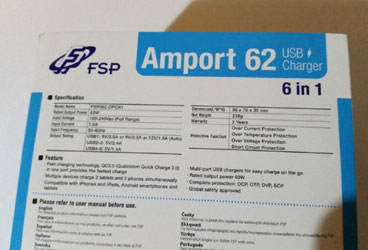
In the box you get the unit itself, a small manual and a power cable. This unit came straight from FSP so had a US-style cable but I'm sure locally-imported ones will have Australian plugs and appropriate approvals.
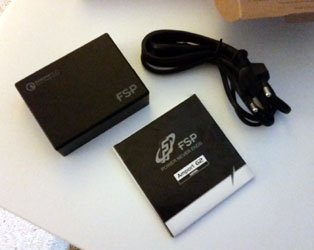 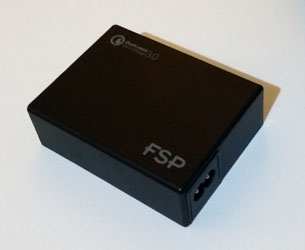
The main party trick of this unit is that it supports Quick Charge 3.0, a standard developed by Qualcomm to allow phones to, as you might imagine, charge more quickly than standard USB charging allows. Sadly I won't be able to test this particular feature today as I don't have a QC3.0-compatible phone for testing. The fact is that you probably don't have one either, as the list of compatible phones is somewhat limited and most notably lacks the words "Samsung" and "Apple". However there are phones from Asus, Blackberry, LG, HTC, Xiaomi and ZTE among others on the list so if you have strayed from The Big Two you might be in luck. There's also a QC4+ standard on the way so stay tuned.
QC3.0 aside, the basic idea of this unit is still quite compelling. You get six USB ports for charging, and you only need to take up one wall socket or one space on your power-board. The power cable uses a standard IEC C7 plug so you can probably pull one out of the back of the clock or radio in your hotel room if you forget yours. The FSP unit takes 100-240V AC so should work anywhere in the world if you use a local C7 cable or a travel adaptor.
 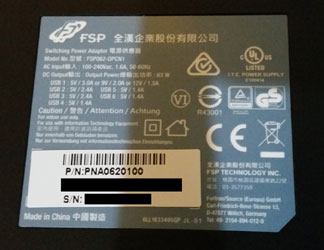
Six USB ports from one power cable is very handy, but it's worth noting that not all the ports on this unit are identical. Port 1 is the only one providing QC3.0, which means if you have a compatible phone you can draw 1.5A at 12V, 2.0A at 9V or 3.0A at 5V. Ports 2 and 3 provide up to 2.4A at 5V while ports 4 to 6 only offer 1.4A at 5V. What does all this mean? Well, check out Apple's page for the power adapters they ship with their phones and you can see generally the iPhones need 1A at 5.1V and the iPads need up to 2.4A at 5.2V. So like the FSP's box says, you can charge 3 iPads (on ports 1-3) and 3 iPhones (on 4-6) simultaneously. Of course, you can plug any USB device into any of the ports and it will charge, but you may as well make sure you are plugged into a port that can give your device the maximum power it can draw, for the quickest charge time.
It's worth noting that there are other fast-charging standards which let devices draw more than the basic 2.4A at 5V, such as Mediatek Pump Express, OnePlus Dash Charge and Motorola TurboPower. Generally you only get the benefit of those fast-charging modes if you use the special charger provided with the device. It's unlikely that the FSP unit will negotiate into a higher-power mode with any device unless it specifically supports QC3.0.
So, how do we test all this? I first experimented with an app called Ampere which reports info about your battery and charge status. It's interesting enough but doesn't have all the info we need - most notably the charging voltage. The voltage they list seems to be the battery discharge voltage, not the voltage the phone is receiving from the cable. Also I couldn't make it give me a readout on one particular phone, and finally if we wanted to include Apple devices in this comparison we'd need a similar app on that side of the fence. So I decided to bypass the whole thing and simply measure what is coming from the FSP unit and into the cable, using a USB power meter.
This one I picked up on eBay is a Keweisi unit and seems fairly well regarded given the cheap pricetag. There's a more electronics-nerdy review of it here thanks to Gough Lui. The idea is simple - you plug it into a USB port, plug the USB cable into the other side, the little OLED screen lights up and reports voltage and current.
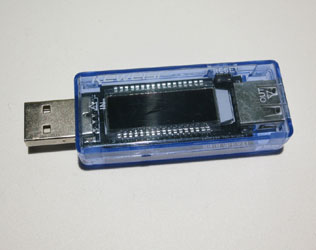 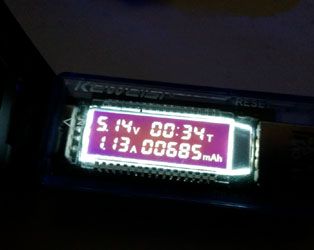
Like most households we have a motley crew of devices that need charging via USB. My trusty Samsung Galaxy S5, an iPad Mini 2, a Ulephone Power and Ulephone Power II (more on them later), my wife's Huawei P9 and some USB power packs were all tested on the FSP unit with the USB power meter. I also tested to see how they charge on their own chargers - the ones I could find! Finally, because many phones will charge at a high rate when the battery is very low then throttle back as the battery fills up, I tested the phones when almost fully flat and when almost full. Of course I also tried the various ports on the FSP unit to test their differing capabilities. I also left them connected for several minutes each time in case it took them a while to negotiate a higher charge rate. With several of the phones you would see them draw 0.4A for a few seconds, then move up to a higher rate.
One unusual result was that the iPad Mini 2 would only draw 0.9A from Port 1, but when I moved it to any other port on the FSP unit it would draw 1.4A to 1.5A. Otherwise the results were as expected - none of the gadgets could pursuade the FSP unit to output more than 5V. All the devices charged fine on the FSP - as well as they did on their own chargers - but those with higher charging modes were not able to access them on the FSP unit. The Ulefones for example were pulling 1.7A at 9.4V from their own chargers thanks to Pump Express, but only 1.2A at 5V from the FSP. This isn't the fault of the FSP unit, but it's worth bearing in mind. Of course if the device you're charging doesn't have a fast-charge function then it makes no difference and it will charge normally on the FSP anyway.
I also wanted to make sure the Amport 62 was providing full power to all six ports at once. However at about this point my USB meter called an end to proceedings, by suddenly giving weird readings even when only one device was being charged, and in some cases making the phones drop in and out of charge mode when it was on the cable. The USB meter has no manual or instructions so I need to experiment to work out if it's faulty or just in some weird mode. So, in a more simple and real-world test, I simply plugged in six almost-flat devices and went to bed. In the morning they were all charged. That's pretty much how I will always use this charger so I'm happy enough.
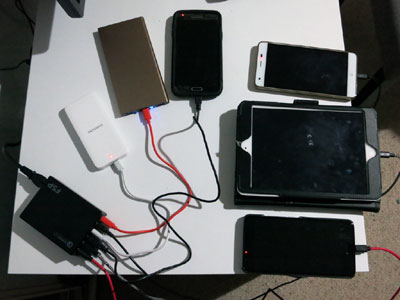
So where does that leave us? If you are someone who needs to charge their phone quickly and you don't have a QC3.0-compatible device, bear in mind that the FSP unit won't engage your fast charge mode. If you DO have a QC3.0 phone then you're in luck, although we were unable to test that feature because of the limited devices that support it. However if you just want the convenience of charging six USB gadgets at once and only needing one power cord, this is also an excellent solution. Personally I generally charge my gadgets overnight and then I'm out and about during the day, so it doesn't really bother me how long the phone takes to charge as long as the LED is green in the morning. Will I be taking the FSP Amport 62 on my next trip? Absolutely. In the meantime it sits on my desk, ready to charge whatever needs charging.
Thanks to FSP for providing the review unit. Pricing and availability seem a bit up in the air at the moment, but FSP let me know that Anyware are now distributing these units in Australia, so keep an eye on your favourite retailer.
Feel free to discuss this review in this thread!
|
|
Advertisement:
All original content copyright James Rolfe.
All rights reserved. No reproduction allowed without written permission.
Interested in advertising on OCAU? Contact us for info.
|

|


